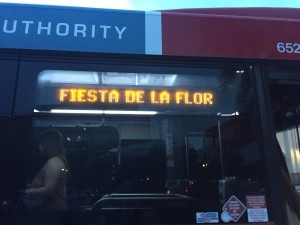Riding the shuttle down to Shoreline Boulevard, I listen to a young woman animatedly sharing the details of her journey to Corpus Christi. Wearing a white v-neck shirt with Selena bedazzled in pink rhinestones on the front, she says, “Well I’m coming from the Valley, and I made these shirts for all my girls that were coming with me. We’ve been planning this ya for months. I sewed each rhinestone by hand! But then my girl Angie from San Antonio couldn’t come last minute y se me quedó con su blusa! Se me quedó!” Everyone on the bus is in shock that a person would decline their ticket to the Fiesta de la Flor, even worse losing a custom made Selena shirt in the process. Instantly making friends with those around her, the woman sells her shirt for cheap to the lady a couple rows behind, who is happy to give her a few dollars for the custom design. By the time I reach the festival, I know where almost everyone on my bus has come from, and I know for sure that Angie has truly missed out.
In her book Selenidad, Deborah Paredez explores what the collective memory and mourning of Selena has done for the Latina/o community. She explains how the veneration of Selena’s death “has generated an (after)life of its own,” which has “galvanized Latina/o efforts to mourn collective tragedies and to envision a brighter future (6-7). For Paredez, the particular death of Selena and the Latina/o performance of mourning her illustrates “how acts of cultural memory and cultural mourning can generate and transform concepts of national, racial, and gender identities” (8). Although it was written six years before the first ever Fiesta de la Flor in April 2015, I saw Paredez’s vision as I traveled back to my hometown, witnessing how our collective mourning not only brings us closer together, but also generates a Latina/o identity that can stand firm against the injustices of the past and look onward toward the future, to a place where our group identity not only holds meaning, but also holds potential for change.

For the Fiesta de la Flor, Corpus Christi put out all the stops. A huge banner welcomed you, with Selena’s beautiful image painted on the front and outlined in white lights. The entire bayfront area, from one edge of the sea wall to other, was repainted, and new palm trees were planted among paved and lit pathways. People and families of all ages, wearing their newly purchased Selena shirts or handmade costumes, were strolling around hand in hand, or sitting on the sea wall listening to the ocean play against the sounds of live Tejano music. Sure, there were long lines for raspas, drinks, and souvenirs, but it really didn’t seem to bother anyone. People were more than willing to stand in line for an hour to buy a shirt or poster, because not only were they doing it for their girl Sel, but it was the way in which they participated in their Latina/o community and performed their Latinidad, sharing memories and singing songs. We knew we were doing this for our barrio girl from Molina street–a girl who very easily could have been us.
Hands down, the most central aspect of the Fiesta de la Flor was the music. For two days, different Tejano bands played throughout the day, from Los Lobos to Little Joe y La Familia, and then the most highly anticipated act, A.B. Quintanilla and the Kumbia Kings. The band, whose members include Selena’s brother and husband, played their original songs, Tejano classics, and Selena covers all throughout their set. As I stood in line waiting for my shirt, I sang along to the Kumbia Kings’ hip-hop cover of the Juan Gabriel standard “No Tengo Dinero,” and I let out gritos chanting “Llorar y Llorar” with the viejitos standing alongside me. But the dancing. Oh! The dancing. With every song, young couples were trying out new moves or old couples were dusting off their tried and true steps. Young girls twirling along in their red glitter bustiers, and men double-fisting Miller Lite as they joyfully danced their way through the throngs of people.
The Kumbia Kings’ final performance, Como la Flor, was the highlight of the entire festival. It was in that moment that I felt a belonging with my hometown community that I have never felt before. Stepping onto the field of dancing and spinning bodies, we were in a constant motion of mourning and celebrating our beloved Selena in a way that brought no tears. Twirling my way through the crowd, collectively chanting, “Aye aye aye! Como me duele!” while A.B. instructed our chorus, “Más fuerte, más fuerte!” we became a united front, not only performing our grief but performing our collectivity. Mourning Selena together bonded us in a way that surpasses understanding. It formed our community identity. That night, together and united as one, we had the power to do anything–for Selena.

